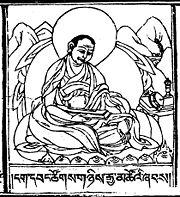Ngawang Tsoknyi Gyatso
| PersonType | Category:Classical Tibetan Authors |
|---|---|
| MainNamePhon | Ngawang Tsoknyi Gyatso |
| MainNameTib | ངག་དབང་ཚོགས་གཉིས་རྒྱ་མཚོ་ |
| MainNameWylie | ngag dbang tshogs gnyis rgya mtsho |
| AltNamesTib | འཛམ་ཐང་མཁན་པོ་ཚོགས་གཉིས་རྒྱ་མཚོ་ · ཚོགས་གཉིས་རྒྱ་མཚོ་ |
| AltNamesWylie | 'dzam thang mkhan po tshogs gnyis rgya mtsho · tshogs gnyis rgya mtsho |
| YearBirth | 1880 |
| YearDeath | 1940 |
| BornIn | rab kha grong sde ('Dzam thang, A mdo.) |
| TibDateGender | Female |
| TibDateElement | Iron |
| TibDateAnimal | Dragon |
| TibDateRabjung | 15 |
| TibDateDeathGender | Male |
| TibDateDeathElement | Iron |
| TibDateDeathAnimal | Dragon |
| TibDateDeathRabjung | 16 |
| ReligiousAffiliation | Jonang |
| StudentOf | thub bstan dge legs rgya mtsho · 'dzong bo skyabs mgon · ngag dbang chos 'dzin |
| TeacherOf | blo gros grags pa · smon lam bzang po · ngag dbang bsod nams bzang po · gsang sngags rgya mtsho |
| BDRC | https://www.tbrc.org/#!rid=P7843 |
| IsInGyatsa | No |
| BnwShortPersonBio | Tsoknyi Gyatso [was] a scholar of the Jonang tradition who was considered an incarnation of one of Dolpopa’s major disciples, Nyawon Kunga Pal (1285-1364) . . . Tsoknyi Gyatso’s writings are not only intriguing and perplexing because they present a specific species of zhentong, but they are important because they disclose to us the intentional workings of a major Jonang scholar during a fascinating period in far eastern Tibetan history. As a disciple of the great Jonang master from Dzamthang, Bamda Thubten Gelek Gyatso (1844-1904), Tsoknyi Gyatso was undoubtedly exposed to a rich nexus of views. Having lived at the crossroads of intellectual exchange during the height of the Rimé eclectic movement in Kham, Bamda Gelek studied with masters including Jamgon Kongtrul (1813-1899), Jamyang Khyentse Wangpo (1820-1892), Dza Patrul (1808-1887) and his Geluk teacher Akon. With these mentors close to his own teacher’s heart, it is safe to infer that Tsoknyi Gyatso was not only versed in the mainstream zhentong works of his own tradition from authors such as Dolpopa and Taranatha, but that he most likely inherited ways of thinking through alternative presentations of emptiness. (Source Accessed October 23, 2019) |
| Other wikis |
If the page does not yet exist on the remote wiki, you can paste the tag |

